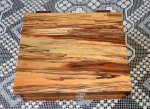- Messages
- 8,468
- Location
- Yorktown, Virginia
I've been playing with the new iBox and wood hinge jigs and these are the first products. I'm a bit concerned about the cross grain glue job on the hinges and wonder if they will hold up. They are essentially cigar boxes with fancy lids, but the wife likes them and has claimed first dibs. I'm experimenting with finishes and haven't found one I really like yet. The sides are made from Brazilian koa flooring cut offs that were planed down to 3/8" thickness for use as CBG finger boards, but which ended up being too short. Tops are 3/8" thick and overlap the bottom on three sides to facilitate opening (with arthritic fingers). The bottoms are all 3/16 prefinished plywood, floating in a groove. I'm not real happy with the floating plywood bottom. It would be nice if the bottom was as nice as the top, but I'm not sure how to go about it and not violate the wood movement rules. Anybody glue their box bottoms? I used Titebond II for the glue ups. The inside sides of the boxes haven't been finished. I'm thinking shellac, or maybe just wax. Thanks for looking.
This one is roughly 9.5" x 11' x 3' with a spalted sweetgum top and 3/8" padouk hinges. Finish is two coats of Minwax Antique Oil.


This one is roughly 6" x 13" x 3" with a spalted silver maple top and 3/8" padouk hinges . Finish is four coats of Waterlox Original and I'm waiting a while before I rub it out to get rid of the dust nibs.


This one is 6.5" x 8" x 3" with a spalted silver maple top and 3/8" cherry hinges. Finish is two coats of Watco Danish Oil (natural).


This one is 6.75" x 16" x 3" with a spalted silver maple top and 3/8" padouk hinges. Finish is three coats ofWatco Danish Oil (natural). This box tried to self destruct a couple of times. My clamps slipped when I was routing the hinge slot on the inside, so there is a boo boo patch, and I accidentally dropped it when I was finishing it and broke a hinge. I was able to use the heat gun to soften the glue and then replaced the hinge.


This one is roughly 9.5" x 11' x 3' with a spalted sweetgum top and 3/8" padouk hinges. Finish is two coats of Minwax Antique Oil.


This one is roughly 6" x 13" x 3" with a spalted silver maple top and 3/8" padouk hinges . Finish is four coats of Waterlox Original and I'm waiting a while before I rub it out to get rid of the dust nibs.


This one is 6.5" x 8" x 3" with a spalted silver maple top and 3/8" cherry hinges. Finish is two coats of Watco Danish Oil (natural).


This one is 6.75" x 16" x 3" with a spalted silver maple top and 3/8" padouk hinges. Finish is three coats ofWatco Danish Oil (natural). This box tried to self destruct a couple of times. My clamps slipped when I was routing the hinge slot on the inside, so there is a boo boo patch, and I accidentally dropped it when I was finishing it and broke a hinge. I was able to use the heat gun to soften the glue and then replaced the hinge.


Last edited:

 Oh boy you got some nice lids there. That spalted silver maple is unbelievable.
Oh boy you got some nice lids there. That spalted silver maple is unbelievable.